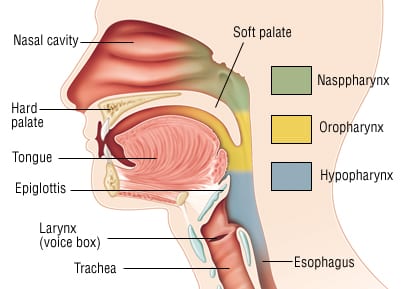Patient Basics: Epiglottitis
Originally published by Harvard Health.
What Is It?
The epiglottis is the flap of tissue located just above the windpipe (trachea) that directs the flow of air and food in the throat. When we breathe, the epiglottis moves to allow air into the lungs. When we eat, the epiglottis covers the top of the windpipe, so that food goes into the swallowing tube (esophagus), and not into the lungs.
Epiglottitis is a rare, but potentially life-threatening infection. It causes sudden swelling of the epiglottis, which often worsens rapidly, sometimes within hours. Without timely treatment, the epiglottis can become so large that it blocks the windpipe, making it hard to breathe. This can cause death.
Epiglottitis can occur at any age. Until 1985, epiglottitis occurred most commonly in children aged 3 to 7, but with the development of a vaccine against Haemophilus influenzae type b (Hib), epiglottitis is now increasingly rare in vaccinated children.
Symptoms
The most common signs and symptoms of epiglottitis include:
- Severe sore throat that comes on suddenly
- Fever
- Shortness of breath or difficulty breathing, especially when lying down
- Drooling and difficulty managing saliva in the mouth
- A loud sound heard when breathing in (called stridor)
- Difficulty swallowing
- Muffled voice
- Preference for sitting upright with neck extended and face tilted slightly upward in a “sniffing” position to be able to breathe
Diagnosis
Epiglottitis is an emergency. If you think your child has this infection, seek emergency help immediately. Never try to look down the throat of a person who is suspected of having epiglottitis. Pressing on the tongue to look down the throat may cause the epiglottis to swell even more and further block the airway.
X-rays of the neck sometimes can show an enlarged epiglottis, but the time needed to take the X-rays may delay other important tests and treatment.
After doctors in the hospital confirm that the epiglottis is inflamed, the airway is kept open using a breathing tube. Blood tests and/or throat swabs are done to determine which organism is causing the infection.
Expected Duration
Most people begin to recover within 24 to 48 hours after receiving antibiotics. Breathing tubes usually can be removed soon after that. It may take up to a week or more to recover completely.
Prevention
Most cases of epiglottitis in children can be prevented by having children vaccinated against Hib and pneumococcal infections.
Treatment
Epiglottitis needs to be treated in the hospital so the person’s breathing can be monitored. If the person is having trouble breathing, he or she may need to have a breathing tube inserted in his or her throat.
Antibiotics should be started immediately after breathing is stabilized and blood samples and throat swabs are taken. Antibiotics usually are given through an intravenous line (into a vein). Once the infection is under control, antibiotics can be taken by mouth until treatment is complete. Additional medicines may be given to control fever and pain.
When To Call a Professional
Call an ambulance at the first sign of unexplained breathing difficulty, especially if accompanied by a sore throat, fever, drooling or noisy breathing.
Prognosis
With proper treatment, people usually recover completely. The key, however, is recognizing the symptoms early, so that treatment can be started before difficulties begin.
Additional Info
American Academy of Pediatrics (AAP)
141 Northwest Point Blvd.
Elk Grove Village, IL 60007-1098
Phone: 847-434-4000
Fax: 847-434-8000
http://www.aap.org/
American Academy of Otolaryngology — Head and Neck Surgery
One Prince St.
Alexandria, VA 22314-3357
Phone: 703-836-4444
http://www.entnet.org/


